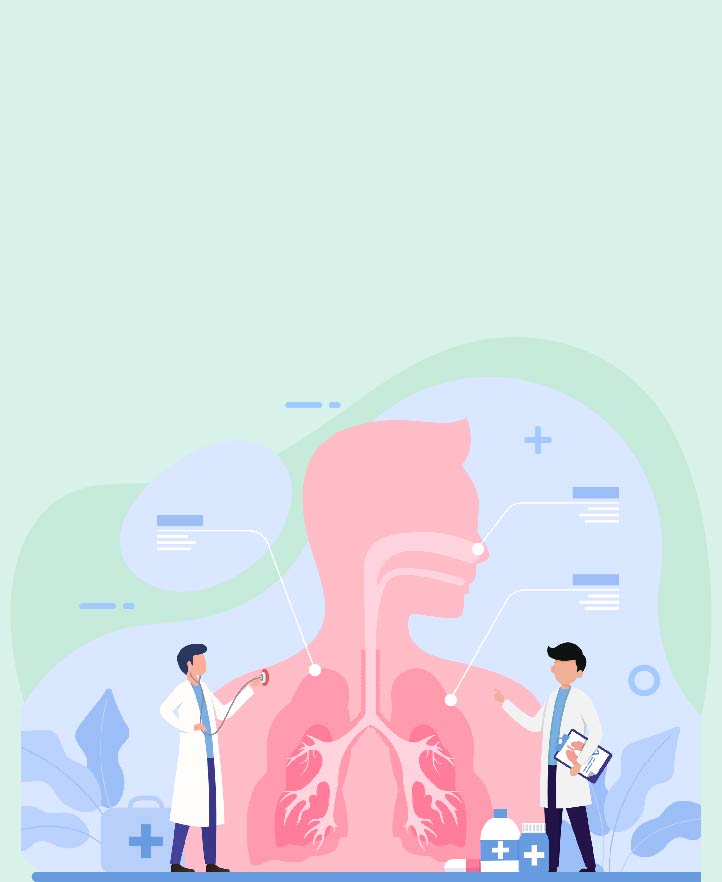

All You Need To Know About Lung Abscess
A lung abscess is a serious infection where a part of your lung fills with pus. It often occurs after pneumonia or when food or liquid accidentally enters the lungs. While you may experience various symptoms, the good news is that most people recover with antibiotics, and only a few require additional treatment. Seeing a doctor early and treating the infection immediately can help prevent complications and protect your lung health. Read on to know about what a lung abscess is and its symptoms, causes and treatment.
What Is a Lung Abscess?
A lung abscess is a cavity in the lung that forms when tissue breaks down due to an infection. This space fills with pus, dead cells and fluid. It is usually caused by bacteria, although fungi or parasites can sometimes be responsible. The infection leads to inflammation and tissue destruction, creating a hollow area surrounded by inflamed tissue. It often occurs in one lung and in the lower parts, especially if a person has inhaled food or liquid accidentally.
Symptoms
The lung abscess symptoms usually develop slowly over time, but in some cases, they can appear suddenly and get worse quickly. One of the most common and noticeable signs of a lung abscess is persistent cough. In the beginning, the cough may be dry, but as the infection progresses, it often becomes productive, meaning it brings up phlegm or mucus. The mucus may have a bad smell, taste sour or even contain blood or pus.
The illness can be either acute (lasting less than six weeks) or chronic (lasting longer than six weeks). Here’s a breakdown of the typical symptoms:
Early Symptoms:
• Fever (often 101°F or higher) and chills
• Night sweats
• Dry cough that may later produce mucus
• Loss of appetite
Later Symptoms:
• Chest pain, especially during deep breathing
• Coughing up blood (hemoptysis)
• Shortness of breath
• Foul-smelling or bad-tasting sputum
• Fatigue and weakness
• Unintentional weight loss
• Clubbing, a change in the shape of the fingernails, where they become rounded and spoon-like
What Causes a Lung Abscess?
Primary Lung Abscess
Common causes and risk factors include:
• Aspiration of food, vomit, or mouth secretions:
This is the most common cause. It usually happens when a person is unconscious, sedated, intoxicated or has swallowing problems. The inhaled material often contains bacteria that lead to infection and tissue damage.
• Pneumonia:
A serious or untreated lung infection, especially aspiration pneumonia, can develop into an abscess if not managed in time.
• Alcohol use disorder:
People who misuse alcohol are more likely to inhale stomach contents and have weakened immune defences, both of which increase the risk of infection.
• Lung conditions and blockages:
Diseases like bronchiectasis, cystic fibrosis, lung bruises or lung cancer (especially squamous cell carcinoma) can block airways and create a breeding ground for bacteria.
• Weak immune system:
People with conditions like HIV/AIDS or those undergoing chemotherapy are more vulnerable to serious lung infections.
Secondary Lung Abscess
They can result from:
• Infections travelling through the blood:
For example, bacteria from an infected heart valve, IV line or drug injection site can reach the lungs and cause abscesses (known as septic emboli).
• Nearby infections spreading to the lungs:
Infections from the oesophagus, chest (mediastinum) or under the diaphragm can move into the lung tissue.
• Airway obstruction:
A blocked airway, due to a tumour or foreign object, can lead to trapped secretions and secondary infection.
Diagnosis
To diagnose a lung abscess, your doctor will start by discussing your symptoms and reviewing your medical background, including any recent surgeries or risk of aspiration. Then, the doctor might perform some tests, including:
• Chest X-ray:
Shows the location and size of the abscess.
• CT scan:
Offers a clearer view of the abscess and helps rule out other conditions like cancer.
• Sputum test:
Analyses mucus or pus to identify the infection-causing bacteria.
• Bronchoscopy:
Used if the abscess isn’t improving or if a blockage or foreign object is suspected. A narrow tube is passed into the lungs to collect samples or examine the airways.
Treatment
The main lung abscess treatment is antibiotics. Most patients start with antibiotics given through a vein (IV) for a few weeks, then switch to oral medicine. Treatment usually lasts 3 to 8 weeks, but in some cases, it may continue for several months until the infection fully clears.
If the abscess is large, typically 6 cm or more, the doctor may need to drain the pus. This involves placing a tube through the chest into the abscess using CT guidance.
Surgery is rarely needed but may be required if the abscess doesn’t improve with antibiotics and drainage. In severe cases, part of the lung, or rarely, the entire lung, might need to be removed.
Complications
If not treated properly, a lung abscess can lead to some serious problems, such as:
• Chronic abscess:
If the abscess doesn’t heal within six weeks, it’s considered chronic and may need longer treatment or further tests.
• Empyema:
Sometimes, a large collection of infected fluid accumulates around the lung near the abscess, causing that area to fill with pus. This can make breathing more difficult and may require drainage.
• Bleeding:
In rare cases, the infection can damage a blood vessel in the lung, leading to heavy bleeding, which is a medical emergency.
• Bronchopleural fistula:
This is an unusual opening between a large airway in the lung and the space around the outside of the lung (the pleural space).
Conclusion
A lung abscess is a potentially dangerous lung infection, but with timely diagnosis and proper antibiotic treatment, most people recover well. If you have a cough that doesn’t go away or other concerning symptoms, it's best to seek medical help early. This is where having a health insurance plan becomes especially important. A good plan can cover the costs of hospital stays, imaging tests, specialist visits and advanced procedures like bronchoscopy or surgery. This makes it easier to get the care you need and saves you from worrying about high medical bills.
One of the important components of our overall wellness is also being financially secured. Healthcare emergencies can happen any time, but a good health insurance policy can protect you from such uncertain situations. To know more about Wellness and other health related tips, visit the wellness corner.
Sources: verywellhealth.com, webmd.com, healthline.com
Disclaimer: This blog provides general information and discussions about health and related subjects. The information and other content provided in this blog, website or any linked materials are not intended and should not be considered or used as a substitute for medical advice, diagnosis or treatment. Kindly contact your doctor before starting a new medicine or health regime.
Related Articles
Tips for keeping Whole & Healthy Lungs
Published on July 8, 2025















 Health Insurance
Health Insurance  Travel Insurance
Travel Insurance  Car Insurance
Car Insurance  Cyber Insurance
Cyber Insurance  Critical Illness Insurance
Critical Illness Insurance
 Pet Insurance
Pet Insurance
 Bike/Two Wheeler Insurance
Bike/Two Wheeler Insurance  Home Insurance
Home Insurance  Third Party Vehicle Ins.
Third Party Vehicle Ins.  Tractor Insurance
Tractor Insurance  Goods Carrying Vehicle Ins.
Goods Carrying Vehicle Ins.  Passenger Carrying Vehicle Ins.
Passenger Carrying Vehicle Ins.  Compulsory Personal Accident Insurance
Compulsory Personal Accident Insurance  Travel Insurance
Travel Insurance  Rural
Rural